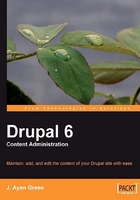
What this book covers
In every chapter you will find discussions and activities on an aspect of Drupal meaningful to the Content Editor. Each chapter builds on the knowledge gained from the prior chapters. Following is a summary of each chapter:
Chapter 1-The Grand Tour
The beginning of the journey:
- About Drupal
- About a Content Management System
- The target audience
- What will be done in the chapters
- A tour of Drupal
Chapter 2-Content Creation
Creating page and story content from the user side:
- The methods of entering text (plain text, plain text with tags, Rich Text Editor)
- The other fields that can be present on the content submission screen
- The various content creation and editing capabilities that can be allowed or denied for each type of user
- Create a new article using plain text by pasting and then adding to it
- Create an article with additional formatting, by using tags
- Create a story using a Rich Text Editor
Chapter 3-Content Seasoning
Adding elements to your content to spice it up:
- Teasers
- Links
- Images
- Embedded sound
- Embedded video
- PDFs
- Attachments and uploading
Create an article to promote a new CD, with:
- A teaser for the front page
- A link to the artist's web site
- An image of the CD cover
- A clip of the music
- A video of the artist commenting on his work
Chapter 4-Content Editing
The elements of basic content administration:
- Full HTML and PHP content input
- Revisions
- Making some changes to the article that you have created
- Using a PHP snippet to provide content
- Editing a revised article
Chapter 5-Making Content Findable
What to do with the content so readers can find it:
- Paths, taxonomy and tags
- Publishing the article created in the previous chapter
- Performing some basic Search Engine Optimization by creating a URL and category tags to complement the content
Chapter 6-Rich Content Types
Understanding the most popular Rich Content types available and their uses:
- Blogs
- Blocks
- Views
- Creating a text block in order to make content available in multiple locations
- Creating a video block to use in the site margin
- Creating a view to display content of similar subject matter
- Creating a blog entry
Chapter 7-Building a Team
When a site moves from static content or low-volume content to something larger, more people are needed, as are more specific operational roles. You will learn about the tools available for enabling this:
- Roles
- Content types
- Permissions
- Access Rules
- Post Settings
Setting up the framework for a creative team:
- Create a new role so that you can have editors
- Allow for a hierarchy of Content Editors Block Editors, Article Editors, and overall Content Editors
Chapter 8-Offline Content Creation
Options for editing content offline, their benefits, and pitfalls:
- Cutting and pasting
- Blog API
- Mailhandler
- Using each of the methods that you have learned to send content to the project site
- Downloading and installing a 'clean' copy of Drupal
- Downloading Drupal
- Creating a MySQL database
- Installing Drupal
- Confirming that it works
Where to find:
- Help
- Documentation
- Modules
- Themes
- More Packt guides